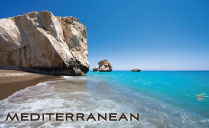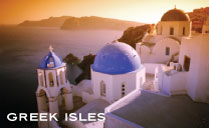Paradise Found by Captain John Borden
The Saronic Islands of Greece, Part II
37.50 Degrees N. Lat/23.50 Degrees E. Lon
 With the conclusion of the Greek Orthodox Easter Week-end and all the colorful festivities and enormous feasts on the isles of Aegina and Poros, it was time to move on to the third island on our itinerary. As I mentioned in last month’s article, our home for the week was aboard the extremely comfortable and very sleek motor yacht Myrine. Aboard Myrine, my wife Carole and I were treated to superb traditional Greek dishes and found the crew extremely hospitable. They were quick to share their vast knowledge of local Greek customs, architecture and history, including the rich ancient history of the Saronic Gulf.
With the conclusion of the Greek Orthodox Easter Week-end and all the colorful festivities and enormous feasts on the isles of Aegina and Poros, it was time to move on to the third island on our itinerary. As I mentioned in last month’s article, our home for the week was aboard the extremely comfortable and very sleek motor yacht Myrine. Aboard Myrine, my wife Carole and I were treated to superb traditional Greek dishes and found the crew extremely hospitable. They were quick to share their vast knowledge of local Greek customs, architecture and history, including the rich ancient history of the Saronic Gulf.
Heading south from Poros, Myrine rounded the headland of Hydra’s main port shortly after sunset, unveiling the most picturesque harbor in the Saronic Gulf. Pronounced E-dra, the horseshoe-shaped bay is alive at night with a cosmopolitan gleam of electric lights from the top of the mountain village down to the waterfront streets below. Also captured in the dark evening waters of Hydra’s main port are the reflecting lights of a hundred yachts and local craft clustered along the main street wharf and extending docks. The bay is magnificent, particularly in the early evening, with all the tiny shops and street-side cafes still bustling with visitors but only visitors, as there are absolutely no vehicles of any kind to crowd the scene or disrupt the atmosphere. Hydra, however, can hardly be referred to as a sleepy little island. For just as the shops close up, the nightclubs and discos are in full swing. In fact, Carole and I found a few of the more popular clubs reduced to long lines and standing room only. We finally stumbled across a small back street tavern where, much to our chagrin, we found two of Myrine’s crew members, very much in their own element. After spotting us, they tried feebly to compose themselves. Of course, it didn’t matter, and after I bought a few rounds and they had danced with Carole a few times, any semblance of formality was quickly forgotten.
By day, the view of Hydra’s rocky terrain is filled with whitewashed, tile roofed villas and mansions clustered densely near the waterfront and becoming more sparse as one approaches the top of the steep mountainside. Many of the larger mansions date back to the 18th century when Hydra rose to power as a prominent shipping port. Today the maritime tradition of the isle, once dubbed “Little England”, continues as home base for the Merchant Navy School.
There are a number of wonderful galleries scattered throughout Hydra, as the island in recent years has become an art Mecca for Greek painters and art lovers alike. One is easily inspired by Hydra’s narrow winding stairways and spectacular overlooks. The island’s charm takes on an especially colorful hue if you make your way up by foot or donkey to the heights where ancient ruins emerge from steep fields of wildflowers. Even farther up you’ll find churches and monasteries which dot Hydra’s rugged slopes. At the gate of one such monastery we found a curious guardian who approached us shaking her finger. In a great contrast to the vivid hillside she was dressed in drab brown. Under her covered head and shoulders we could see the wrinkles from Greek summer suns and wiry limbs showing years of toil. Smiling all the while, she rapidly vocalized some sort of complaint in her native tongue. It is times like these that sign language can take you a long way. Pointing to our cameras and waving her arms emphatically, her message of no pictures was finally communicated. After leading us through the monastery grounds chattering nonstop, she conveyed her final message by sign. This one was unmistakable as she reached out with one arm, still grinning, her palm facing up.
 The following day we arrived in Spetses which, unlike Hydra, permits a few vehicles to travel her streets. There are not many, however, as the island’s preferred mode of transportation is horse and carriage. One can easily acquire a feeling of being transported to an earlier time when wandering the waterfront streets of Spetses. Surrounding us at Agin marina, where Myrine was berthed at the bay of Argos, where the most extraordinary remains of ancient walls and statuettes dating back over four thousand years to the Helladic era. Much of the island’s heritage has been preserved, not only in the architecture, but in the subtle tradition of meticulous courtyard gardens and the not-so-subtle custom of restaurateurs displaying their goods. If you happen to be an octopus connoisseur, for instance, you are in luck. One local establishment had strung out over a hundred of the slimy creatures for inspection.
The following day we arrived in Spetses which, unlike Hydra, permits a few vehicles to travel her streets. There are not many, however, as the island’s preferred mode of transportation is horse and carriage. One can easily acquire a feeling of being transported to an earlier time when wandering the waterfront streets of Spetses. Surrounding us at Agin marina, where Myrine was berthed at the bay of Argos, where the most extraordinary remains of ancient walls and statuettes dating back over four thousand years to the Helladic era. Much of the island’s heritage has been preserved, not only in the architecture, but in the subtle tradition of meticulous courtyard gardens and the not-so-subtle custom of restaurateurs displaying their goods. If you happen to be an octopus connoisseur, for instance, you are in luck. One local establishment had strung out over a hundred of the slimy creatures for inspection.
Whether you’re in the Mediterranean, Caribbean or Isle of Palms, there is one custom that’s altogether timeless. If you’re simply looking for a beautiful stretch of sand on which to lie down and transform yourself into a bronze god or goddess, there are two gorgeous beaches on Spetses: Agii Anargyri and Agia Paraskevi. If you have problems pronouncing these, just hold up a bottle of sunscreen and ask in your richest Charleston drawl, “Which way to the beach?”
The Saronic Gulf islands of Greece are wonderful to explore, particularly in late spring and summer when the crystal waters of the Med have warmed and you can swim and snorkel along the more secluded bays and anchorages. I think what you will find most entertaining, however, are the people themselves, who take great pride in these fascinating and beautiful islands which, for them, are a pleasure to share.
San Remo, Italy and a Riviera Rendevous with the Darling Jade —>





